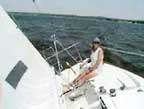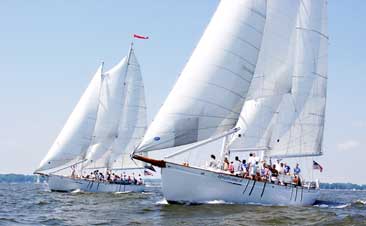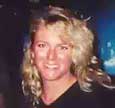|
|
 |
|||||||||||||||
|
Volume 13, Issue 30 ~ July 29 - August 3, 2005
|
||||||||||||||||

|
Meet five women and the sailboats they captain by Alice Snively What do you mean Mama’s run off to sea? Just that. And she’s only one of a growing number of women who are taking up the sea as a profession. Don’t conjure up images of a dining room server on a giant cruise ship. These women are not the marine equivalent of airline stewardess. Women captains on Chesapeake Bay in the 21st century are an intrepid group of sailors. Captain Mary Ann Albright proved the stuff that sisterhood is made of when, on her maiden voyage, she sailed up the Atlantic coast into a storm. “I was stuck in that 50-knot gale for 12 hours, and my radar was knocked out.” Was she scared? “No,” she said. “It was tense, but I wasn’t scared. I’ve never really been scared.” Fear doesn’t seem to be a common emotion among these waterwomen. Most say they don’t have time to be afraid; when trouble comes, they’re busy working through it. Intense training coupled with thousands of sea miles traveled under constantly changing conditions enable them to handle the unforeseen. A Different Kind of Pioneer Woman Today’s women captains didn’t appear out of the misty seas of history. Washed out, albeit slowly, by American independence was the myth that women brought back luck to working boats. From the 1800s into the early 20th century, pioneering women headed west; others pioneered marine trades here on Chesapeake Bay. No longer were the wives of Bay watermen relegated to the shore, cleaning and mongering great yields of crabs, oysters and fish. Wives, and daughters began to accompany the men on their boats, crabbing and tonging, hauling in the catches, cleaning, sorting and working as general crew. These small family enterprises were the springboard for even larger roles for women, including captain. Romantic paintings and photographs of beautiful sailing cargo schooners disguise the hardships pioneering women captains faced. Imagine managing a large crew; sailing in foul weather with no radar, depth finder or GPS; feeding the crew from a galley with no electric refrigeration or modern cooking range; handling the business end of hauling cargo, from loading and unloading and keeping financial account of everything. There was no place for daintiness on these magnificent vessels, and quick, correct reaction to changing conditions required sure knowledge of the Bay’s fickle ways. Calvert County’s Susie Langley Brinsfield was the first woman to obtain a skipper’s license for a three-masted schooner in the Baltimore District. She became captain of the schooner Josephine Wingate.
Another captain, Gertrude Edwards Biscoe, worked side by side with her captain husband Clarence Biscoe — whom she married in 1913 — sailing pungy schooners to transport cargo on Chesapeake Bay. After World War I, as the economy began to slide, she and her husband quit the hauling business. In 1925 they settled on Carthagena Creek near Solomons and ran fishing parties, crabbed and tonged oysters. Gertrude Biscoe died in 1987. By the time of these captains’ deaths, revolutions in technology, the economy and the women’s liberation movement had written tickets in the marine profession for a new generation of women. In the new century, they form a sisterhood that encompasses not just Chesapeake Bay but nearly all the world’s waterways. Then as now, they make serious sacrifices to work the Bay and the seas beyond, and they take risks that most women and men prefer to avoid. Why they do this is the natural question, to which there is no simple answer. To find answers, meet five of this sisterhood spanning three generations. Fox Hunting to Foam Jumping Septuagenarian grandmother Mary Ann Albright of Westminster captains a 46-foot Morgan Round the World sailboat. The New York native had lots of sea time growing up, helping her Portuguese father on his deep-sea fishing boat. Becoming a captain was not, however, part of her plan. Horses brought Albright to Chesapeake Bay. As a young woman, she concentrated on marriage and family and raised racing and fox-hunting horses. She and her husband bought a farm in Howard County to further their horse business.
If anything could have scared her out of the water, it might have been that first trip sailing her boat back from the Caribbean. Twelve hours without radar in a 50-knot gale didn’t faze her. Between that stormy rite of passage and her 50-ton master’s license, which she earned in the early 1980s, Albright studied at Annapolis Sailing School and worked with Louise Burke, long-time head of the U.S. Naval Academy sailing program, as well as with Womanship sailing school. “I wanted to get my license because I wanted to teach,” she said. That she did, working as a teacher with Womanship, where she was featured in an ESPN special about that school. In addition to teaching on Chesapeake Bay, she’s done chartered teaching out of Key Biscayne in Florida and on the West Coast. She’s also captained boat deliveries, which “take away any land ties you have if you do them for a living,” she said. On one of those trips, she recalls, “I thought I was heading straight for some big rocks, but I couldn’t find them on any chart. It was dark, and all I could see were these shapes that looked like rocks.” It turned out they were partially submerged submarines coming out of New London, Connecticut. “That was strange, very strange,” she said. Since the death of her husband last year, Albright spends more time on her boat at Maryland Yacht Club where she is a past sail fleet captain and current member of the board of governors. She has resumed private teaching and taught at the club’s Junior Sail Fleet Camp last month. Walking her dogs up the dock as we talked, she took a long look around the boat basin and woods and marsh surrounding it. “I’ve sailed to lots of places,” she said, “but there is no better place to teach and sail than on Chesapeake Bay.” Into the Doldrums To write a story like this, you’ve got to catch up with some very mobile women. Captain Dale Norley returned June 16 from delivering a 48-foot catamaran from Captetown, South Africa, to Trinidad. She’d planned to bring the boat up to Rock Hall, but the owners decided they wanted to keep it in Trinidad for the season. The altered plans were conveyed to her after she was underway, so she had to change course. “That put us in the doldrums for 10 days in very hot weather,” Norley said. That was just one more minor bother. Her diary puts perspective on the challenges of that 5,743-nautical-mile voyage. “The watermaker, plumbing and electrical challenges, water in the fuel, the autopilot replacement project, the spinnaker sock incident, the s
For landed readers, the Intertropical Convergence Zone, or ITCZ, is the doldrums, the common term for an area of low barometric pressure lying in the equatorial belt between the trade-wind regions of the northern and southern hemispheres. Winds in ITCZ are either very light or absent, and the weather is sultry hot. The size and character of the zone varies from year to year and season to season. This is no area for sailboat racing, and it’s understandable that this term is commonly used to describe depression. Note that Norley’s nautical-mile voyage was longer than a familiar statute-mile trip of 5,743 miles. The statute mile is 5,280 feet while the nautical mile is 6,076 feet. The difference carries over to wind speed. One knot of wind speed is equal to one nautical mile, amounting to a harder wind than measured in miles-per-hour weather reports. “I’m still recovering,” Norley said when we talked, noting continued bouts of vertigo and muscle fatigue. “After two months at sea, you expect this. It takes me five or six days to get over it.” Like most sailors who’ve been a long time on the water, favorite foods and drink were the first things on the captain’s mind when she arrived home. “I wanted a bunch of mimosas and fresh fruit salad,” she said, “and that’s what I got.” Norley’s name will be familiar to readers of the sailing magazine Latitudes and Attitudes, where she writes the boat-of-the-month reviews. But Norley is a woman of many talents who has worked in several professions. She took a degree in English from the University of Pennsylvania and also holds degrees in journalism and early childhood development. During her first career, in publishing, she married and had two children. She also studied with the American Institute of Gemology, was certified, became a jeweler. And, like Albright, she grew up with horses and still enjoys fox hunting. Ultimately the sea became her great love and her workplace as a delivery captain. She says the sea is in her blood. The Bryn Mawr, Pennsylvania, native grew up sailing Chesapeake Bay with her family. In 2000, Norley attended captain’s school, earning her 100-ton master’s license. Since then, she’s racked up 80,000 incident-free nautical miles. Now she works primarily with Echo Yacht Deliveries based in Newport, Rhode Island. “They offer the jobs, and I decide if I want them or not,” she said. Most of the time, she also gets to choose her crew.
After some summer fun, Captain Norley will deliver a 56-foot Sundeer sailboat from Barcelona, Spain, across to the Bay and up to Oxford in September. “That ought to be a good trip,” she said. “I love this life.” Woodwinds Play the Bay If you know Annapolis or if you’ve seen Wedding Crashers, you know the schooner Woodwind — or its double Woodwind II. Woodwind II, a 74-foot commercial pleasure schooner docking at the downtown Marriott Hotel, was featured in the film as Christopher Walken’s private sailing yacht. In real life, at the helm of Woodwind is likely to be “five-foot-nothing-and-proud-of-it” Captain Jennifer Brest. How did a 35-year-old Connecticut Yankee come to be master of a pair of 74-foot wooden beauties? Back in 1992 when Brest’s parents, Ken and Ellen Kaye, were planning their retirement from school teaching in Connecticut, she suggested they get “a really big boat and sail around the world.” Hers was an avid sailing family, so the idea wasn’t far-fetched. After much research, they decided to have a boat specially built to offer as charter for people to experience sailing in a safe and comfortable yet exciting environment. Annapolis, the Kayes concluded, was the place to launch their venture. Their new schooner was commissioned in 1993 and certified for 48 passengers. Thus was born Woodwind Charters. Brest finished college, including a semester at sea on a 125-foot vessel, and crewed on Woodwind. In 1996, she earned her captain’s license and joined the family business full-time. Her husband Dan joined the business in 1998, about the same time as the second schooner, Woodwind II. Woodwind Charters offers day sails, overnight and some extended sails. “This job is all about the people,” Brest said. “I want to get people so fond of sailing that they want to keep doing it. We encourage passengers to help steer, raise sails, to participate hands-on with the sailing of the boat. Of course, not all people do; some just want to relax and enjoy.” Brest loves a good adventure, too. Imagine you’re at the helm in a race with some 30 other schooners, trying to be first from Annapolis to Norfolk and sailing right into a weather front heaving 35-knot winds and pounding waves directly at your bow. “That happened to us last year during the annual schooner race,” she said. “It was so wild, some of the crew and passengers were getting sick. Despite our efforts, the boat was literally going nowhere. It’s called ‘bashing your brains to windward.’” They were only 30 miles from the end, but concerned for crew and passengers, she turned the boat to head for safety. “Suddenly, we were really flying,” on what’s called a broad reach, with the wind perpendicular to the boat. “Why not use that tactic,” she said, “try to beam reach across and down the Bay? We did, and it worked.” It worked so well that Woodwind won the race, way ahead of the next nearest schooner; several others indeed dropped out of that race. Brest has done 12 of the schooner races, and Woodwind has been overall winner three times, more than any other boat. “Every cruise, however ordinary it might seem, really isn’t,” she said. Whether it’s weather, equipment or people, there is a challenge. “And I enjoy every one of those challenges.” Brest calls on three other women plus a number of men for crew, but she’s tickled when leading an all-women crew. “I enjoy the reactions of people,” she said. “I particularly like having groups like Girl Scouts aboard with our all-women crew. It’s a way of reinforcing their potential for achievement,” she said. “We are changing perceptions of what it takes to make a big boat go.”
Captain Camille Vickers dreamed of becoming a professional ballet dancer, and she studied diligently toward that end. But she made a compromise with dance that would lead her to Chesapeake Bay and a life dancing on the waves. Competition in professional ballet was too intense and, she said, “cutthroat. I just wanted to dance.” So she married, moved to Vermont, bore two children and opened a ballet school, which grew to an average enrollment of 400 students. She and her husband enjoyed vacation sailing on Lake Champlain, the Hudson River, New England waters and eventually the Virgin Islands. When they divorced, Vickers began to formulate a new life plan. “My goal was to sell the school, retire by the year 2000 and then go to sea,” she said. “I so love sailing, the freedom, the release from stress, the excitement. I knew that was what I wanted.” In January of 2000, the 50-something grandmother did in fact sell her school. By October she had found the right boat, a Pearson 365 ketch she named Dancing Lady. Launching her new career, Vickers started educating herself. She became an American Sailing Association certified instructor in August of 2001. From there she went on to earn her 50-ton master’s license, taking her certificate from Sea School in St. Thomas, Virgin Islands, along with her sailing and towing endorsement and other specialty certifications. On the water, Vickers has filled an array of different roles, including racing crew, sailing instructor, briefing captain and delivery and charter captain, which brings us to another peril of a woman’s life on the sea. Like all these woman captains, Vickers endures the gender challenge. Over time, all agree, as their competence becomes better known, most of their male counterparts come to respect them and work well with them. But first, they’ve got to navigate around doubt. During one delivery Vickers crewed, a storm caused a crack near the top of the mast. In making repairs, the crack had to be sanded. “The captain and first mate each took a turn to go up. It was difficult and tiring,” she said. “But when I suggested it was my turn to go, they refused to let me. I tried to convince them that I was fully competent for that activity, but the captain stood firm. I was, however, good enough to mend their sails.” Vickers got acquainted with Chesapeake Bay through friends who had moved to Pasadena. “I fell in love with the Bay,” she said. “Last year I made the decision to move down here from Vermont.” Whenever she could grab time, she scouted the area for housing and for work. Recently returned from St. Thomas as charter and briefing captain, she reported on the progress of her plan. “I’ve bought a lovely little condominium in Annapolis,” she said. “I’ll be working primarily as a charter instructor with Let’s Go Cruising and Ocean Sailing Academy.” Vickers ranked her new job as “doubly good” because the academy also has a location in St. Thomas. With a son in Philadelphia and a daughter in St. Thomas, she said, “this will allow me to be near both of them at different times of the year and to sail the Bay as well. Life just doesn’t get much better than this.” Captaining a Flotilla As owners of Haven Charters in Rock Hall, captain Jacki Appleton Fife, and her husband Dave, satisfy two loves: sailing and working with people. They’re in their third year of managing a flotilla of 21 boats ranging from 30 to 42 feet. For Fife, Rock Hall is a return to home territory. “My father runs a sailing school in North E  ast, Maryland, so I sailed Chesapeake Bay my growing-up years,” she said. On the Bay, she sailed in local, all-women racing regattas; then, she spent several years in the Caribbean, honing her sailing skills. Eventually, she earned a U.S. Sailing School Certificate and certification as an open-water diver. Both Fifes hold 100-ton master’s license. ast, Maryland, so I sailed Chesapeake Bay my growing-up years,” she said. On the Bay, she sailed in local, all-women racing regattas; then, she spent several years in the Caribbean, honing her sailing skills. Eventually, she earned a U.S. Sailing School Certificate and certification as an open-water diver. Both Fifes hold 100-ton master’s license. The combination of captaining and diving has introduced Fife to drama under as well as on the water. While delivering a boat from Miami to Antigua, she got her first up-close look at sharks — who were also looking at her. “The delivery itself was a dream,” she said. The owners of the boat had no required timeline for the boat’s arrival, so she and her husband sailed for a month, visiting 11 islands, and she got in a lot of diving. “During one dive, I was met by several sharks. It was a total surprise, and it was really scary,” she said, “until I realized they weren’t interested in me for lunch.” These weren’t little sharks, either. “They were about 30 feet long,” she said. “They circled around, inspected me, then swam off a little way. But they kept an eye on me the whole time — and you can bet I kept an eye on them.” Haven Charters called Fife to use her sea skills in a new way, providing people with a pleasant sailing experience that also will bring back good memories of Chesapeake Bay. “I was a travel agent after all,” Jacki said. “For me, it’s all about people — people and sailboats.” The Fifes don’t own the boats they charter. The vessels are owned by a number of people who let them for charter when they’re not sailing. Running crewed and bareboat charters is part of their business, but not all. They also offer sailing lessons at their location and through her father’s school. Dave is an ordained minister. So, Jacki says, “we also do weddings, averaging about six a year.” They call on two larger boats for weddings, corporate events and parties. The 30-something captain and her husband have no children yet, so they’re not tied to one place. That’s a good thing because they also have a Caribbean operation. Chartering is seasonal; when it’s winter here on the Bay, they take working vacations. Every year, they captain a flotilla of boats for a week of sailing in the British Virgin Islands. “There are people who really want to sail the islands but are reluctant, for any number of reasons, to go solo the first time,” Fife said. “We offer them a way to do the sailing and learn their way around.”
Tried, Tough and True Many more women than these make their living on the water. Others are captains of pilot boats, tug boats, water taxis, excursion boats and fishing boats. Earning their captain’s licenses demands hundreds of hours of underway time as well as diligent study to master navigation, safety, repair and maintenance of all types of equipment, maritime law, communication, emergency medical and survival techniques. They sacrifice family, good hair and manicured nails. They deal with Mother Nature’s whims. After long voyages, they suffer vertigo and muscle fatigue. They do without ice, and most of the time they eat on the run. They go without sleep and showers. Theirs is not a pretty business in many ways. They do it because it satisfies an irresistible desire to be on the water. “Still the sunsets beckon us out on deck,” reads an excerpt from Captain Norley’s diary. “We have cheered at the blush of the rain as it moves across the water … have laughed together and enjoyed the solitude of standing alone in the cockpit watching for shooting stars.”
|
|||||||||||||||
|
|
||||||||||||||||
|
© COPYRIGHT 2004 by New Bay Enterprises, Inc. All rights reserved. |








 About the Author
About the Author